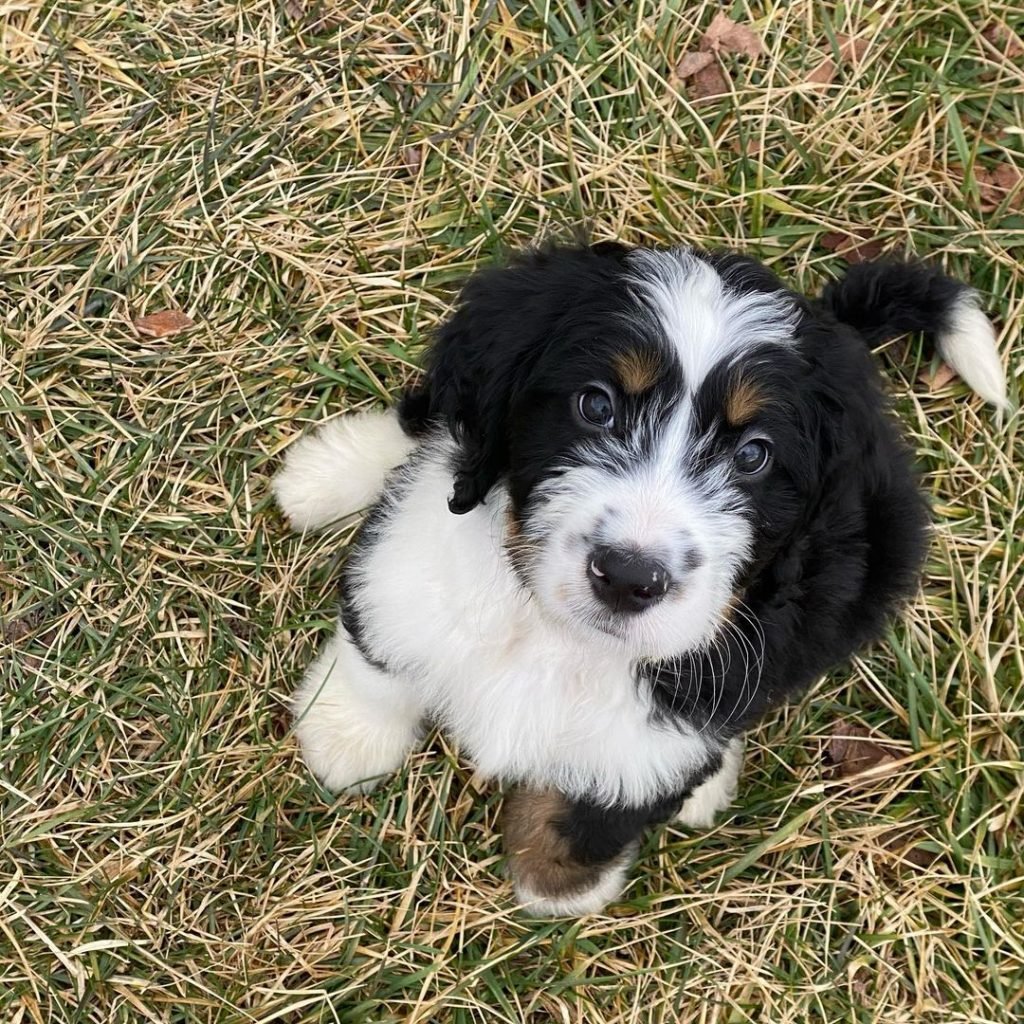
Though you may think it difficult to make any sort of Doodle even cuter, the unique combination of the beautifully-hued Bernese Mountain Dog and the classic Poodle coif create quite the masterpiece in the Bernedoodle. Boasting a variety of coat colours and sizes (everything from tiny to big!), this breed continues to grow in popularity for good reason. Even though they’re a smidge more stubborn than your average Doodle, the Bernedoodle still charms with enthusiasm, energy and never-ending affection for loved ones.
Is a Bernedoodle the right kind of dog for you? There are lots of things to consider when adding a dog to your life, so we’ve covered just about everything you’ll need to know in this in-depth breed profile. We consulted certified professional dog trainer and The Dog People panelist Nicole Ellis, who has long worked with Doodle breeds, breeders and owners, for the essential facts about Bernedoodles.
Key
- Low
- Medium
- High
- Origin: Canada
- Size:
- Weight: 32-41 kg (Standard), 23-32 kg (Medium), 11-22 kg (Miniature), 5-11 kg (Tiny)
- Activity level:
- Barking/howling level:
- Good with dogs: yes
- Good with kids: yes
- Good with cats:
- Shedding:
- Shedding: Seasonal
- Grooming level:
- Training level:
Bernedoodle Appearance
As mentioned above, the Bernedoodle’s appearance can vary dramatically from dog to dog, depending on which parent their genes tend to favour. Most Bernedoodles have a wavy, low-shedding coat that other Doodles also rock, but there can be a few who have straight fur. Their colour variations are unique in that they can be black and white, merle, black, phantom, sable, chocolate or tricolour (which is the most popular/most expensive variation). Heads up—it’s also possible that your Bernedoodle’s fur will fade or lighten with time, due to their Poodle genes.
Between their dense coats and the thick pads on their feet, they’re always up for an outdoor adventure, no matter what the weather is like outside. The fur keeps them cosy in the cold, and protects them from the sun in hotter climates.
The Bernedoodle size can also greatly vary, and is dependent on the size of the Poodle used for breeding. This means that you could end up with a dog that’s anywhere from 4.5 kg (tiny) to 41 kg (standard). The weight and size of your Bernedoodle will depend on what type of Poodle your Bernese was crossed with (there are health concerns to bear in mind here too—more on that later). A toy poodle, for example, could result in a Bernedoodle that is 5 to 11 kg, while a miniature Poodle and Bernese mix could result in a dog that’s 11 to 22 kg. Of course, the standard Poodle and Bernese mix can be anywhere from 23 kg and up. So it’s important to understand what size Poodle your pup is coming from!
Bernedoodle Personality
The opposite of their mixed-breed neighbour the Goldendoodle, Bernedoodles are much more stubborn but just as smart. Though the type of personality you may end up with can be very different, depending on which parent your pup takes after, with the Poodle side being predictably high-energy, and the Bernese side giving off more mellow vibes.
A Bernedoodle can also be incredibly goofy, cuddly and protective, depending on their parent’s personality. Some Bernedoodles are known to be Velcro dogs, which may be a sign of separation anxiety, but still manage to win your heart with their gentle personality. To get an understanding of what your Bernedoodle will be like, it’s best to meet the pup’s parents.
One thing is for sure, a Bernedoodle will be very social and require a lot of attention in the form of exercise, socialisation and training.
Early socialisation (or desensitisation) and training of expectations at a young age will help curb more undesirable behaviours, like the Berner’s sensitivity to strangers. Despite their quirks, they are considered loving, loyal and affectionate to those folks who are lucky enough to call them family.

Ideal Environment for a Bernedoodle
We’ve already established that Bernedoodles have a range of possibilities when it comes to their appearance, and the same rings true when it comes to what they’d consider an ideal environment. From incredibly lazy to very energetic, they are all over the map. Toy and mini Bernedoodles tend to be higher energy, and Standards generally have a calmer demeanour. Most Bernedoodles fall somewhere in the middle; equally happy taking you on a jog around the park, or lounging on the bed watching some Netflix.
Basically, as long as they’re given plenty of opportunities to expend their energy through long walks, dog park excursions or playtime in the garden, this breed can thrive wherever they end up. Bernedoodles are also able to handle cold weather, so families in frostier areas don’t need to worry—though they’re also fine in warmer climates as long as careful attention is paid to make sure they don’t overheat.
Ideal Human for a Bernedoodle
Keep in mind that pet parents find the puppy stages of a Bernedoodle harder than other breeds. In order for this breed to really blossom into their best self, they need a family that’s committed and consistent to their training, and to spending time with them (they love their people, after all). If you’re a dog parent flying solo, you’ll likely need extra support during the puppy stages to get a Bernedoodle’s energy out—while keeping your energy positive.
Socialisation is also key for this breed, and prevents them from getting skittish or overly headstrong. Active families are a great fit for smaller-sized Bernedoodles who tend to be higher energy. Kids can also be wonderful with this breed, so long as they’re aware that the larger doodles will need some training to learn how to keep their strength and size in check. Given the right amount of love, attention, and training, Bernedoodles make wonderful and affectionate family additions.

Bernedoodle Dog Training
Bernedoodle puppies are full of energy, so it’s a great idea to start training them early on—especially if you have a standard size pup who’ll need to learn not to jump up before they get big enough to cause some damage. Bigger Bernedoodles will also grow faster than their awareness of strength, so dialling into loose lead walking and bite inhibition early is important. More importantly, you’ll want to know how to train your dog through their adolescent phases when they decide they know the rules but don’t want to listen.
This breed is clever, so you’ll need to establish boundaries early on, or they’ll quickly learn what they can get away with. You’re also going to want to keep the training sessions fun (involve their favourite toys, etc) and short, so they don’t get bored or stressed out. Doodles are also known for their rough play, which can be intense at dog parks, so teaching your dog when to take a break will be important too.
It has been said that Bernedoodles are a bit more stubborn than other Doodle breeds, and that ‘set in their ways’ mentality can sometimes make training more of a struggle. But that’s also why training is so essential—and luckily many of these dogs tend to be food motivated, which means they’re a tad easier to inspire when it comes to following directions.
It’s also very important to socialise this breed early on by introducing them to a variety of situations, people, animals, and locations. By showing them the world around them, and making them feel comfortable and safe with you as they explore it, they’ll gain the confidence to be the well-adjusted, well-behaved pup you know that they can be. Above all this breed really just wants to please their loved ones, and their smarts and charm mean that any effort you put into training them will be well worth it.
Jelly was a handful when we first brought her home, we think her Poodle side gives her part of her energetic personality but then she can easily switch and is the laziest dog who loves to cuddle on the couch. We love this breed for that reason. She has been very good with training and she is very smart—we bought puzzles for her and she’s already at the advanced level. She enjoys hiking, is still learning how to play fetch and loves anything peanut butter flavoured. She has grown so fast in the last five months since we brought her home (basically doubled in size) and we call her our little bear.
Rani, Jelly the Bernedoodle’s Pet Parent
Bernedoodle Grooming
Since Bernedoodles are rocking a coat that doesn’t really shed, their fur is going to need to be trimmed and groomed regularly to keep it looking its best. Combing and brushing their hair two to three times a week is especially important to prevent painful mats from forming and tangling up their pretty tresses.
This breed doesn’t need to be bathed all that often, as cleaning them too much will strip away the natural oils that keep their coat and skin moisturised. It might also be a good idea to pay a visit to a professional groomer every couple of months to get them trimmed up, and to make sure their ears are healthy, and their nails clipped and tidy.
Bernedoodle Dog Breed Health
Since Bernedoodles are a relatively new breed, it’s hard to predict what the dog’s longevity and overall health is like. This breed (like all breeds) does have a few health issues that can emerge, including hip dysplasia, elbow dysplasia, eye issues, and skin allergies. However, using a reputable breeder (if you’re using a breeder), can help cut down the possibility of your dog having these issues. A Bernedoodle that is 50% Bernese Mountain Dog and 50% Poodle is most likely to be the healthiest.
It’s important to remember that artificial insemination is needed to produce a litter of miniature or toy Bernadoodles that are a 50/50 cross between a Bernese Mountain Dog and a Poodle. And, due to the vast difference in size, the mother must be the Bernadoodle, otherwise a mother carrying a litter of puppies larger than her can have devastating health consequences.
Bernedoodles generally live from 12 to 18 years, with the larger dogs on the lower end of that number, and the smaller ones on the higher end. Providing your dog with proper exercise, food, and regular trips to the vet will help improve their chances of a long and happy life.
Bernedoodle History
Though both Bernese Mountain Dogs and Poodles have a long and well-documented history, the Bernedoodle has only been around for a fairly short period of time. In fact, it’s believed that the first Bernedoodle was bred in Canada in 2003 by Sherry Rupke of SwissRidge Kennels.
Getting a Bernedoodle
The number one fact to keep in mind when getting a Bernedoodle is that you may not be able to anticipate your dog’s temperament, appearance, and health. Because this is a new breed and there are a variety of breeders out there, each person’s experience with a Bernedoodle will be unique.
Bernedoodle Breeders
It’s always a good idea to meet the parents of your puppy, and to see how the litter interacts with each other. This is especially important when choosing a crossbred dog, since you can see just what size the parents are and what their personality traits your dog may have. A good, trustworthy breeder has records of the parents’ lineage and should be able to tell you more about the specific mix of the litter.
Since Bernedoodles aren’t officially recognised by the Kennel Club, you’d need to start your search for a reputable breeder elsewhere. Make sure you wise up on puppy mills and internet scams—following some simple steps can help avoid further funding of this terrible practice, and help you end up with a pet whose breeding and early-life experience will more reliably result in a well-adjusted dog.
Adopting a Bernedoodle
Although rare, Bernedoodles may find their way to rescue centres for a variety of reasons, including dogs being rescued from puppy mills. But often it’s the simple fact that their previous owners simply felt unable to care for them any longer, perhaps due to a change in lifestyle or health.
A surrendered dog will often already be well-trained and simply in need of a new, loving home. You can find rescue centres local to you with a quick internet search. Bernadoodle breeders also occasionally look to rehome dogs.
A Bernedoodle can make for a wonderful friend and they’re sure to be a source of joy, with plenty of laughs and perhaps a little bit of mischief along the way. So whether you’re planning on adopting or finding a breeder to find a puppy, prepare yourself, your home and your heart to welcome a dog with plenty of personality and energy.
More on Bernedoodles
If you’re simply in love with Bernedoodles, then you’ll be craving what we’ve got for you next: